API RP 2A-WSD-2007 Recommended Practice for Planning, Designing and Constructing Fixed Offshore Platforms-Working Stress Design
Подождите немного. Документ загружается.

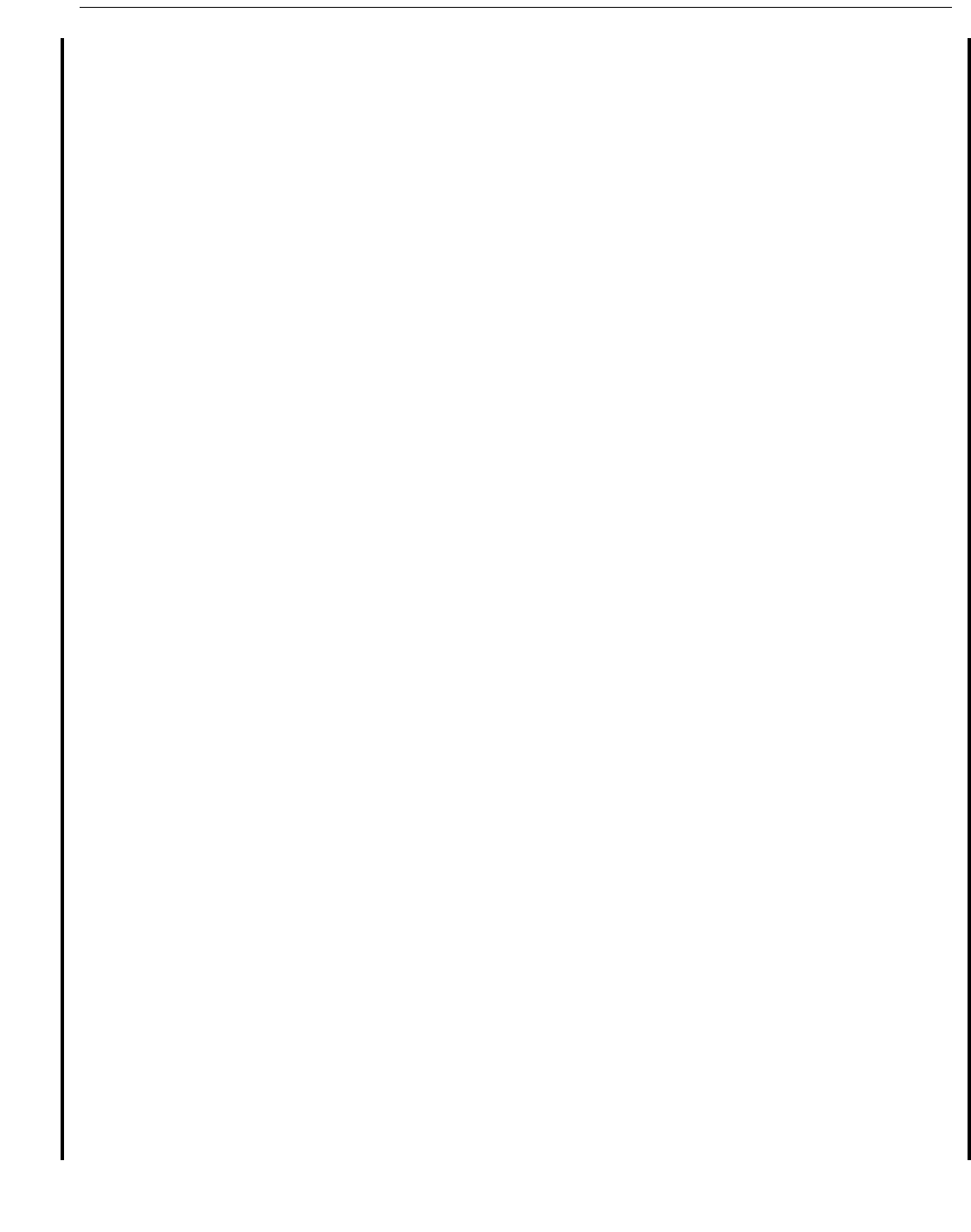
RECOMMENDED PRACTICE FOR PLANNING, DESIGNING AND CONSTRUCTING FIXED OFFSHORE PLATFORMS—WORKING STRESS DESIGN 179
dimensions are unchanged, but measurement does not
include thickness tapers.
The guidance on overlap dimension has been changed to
simplify analysis and make measurement easier during fabri-
cation. However, there is no need to treat the preferred mini-
mum as a hard and fast rule. There are many practical
instances where only minor overlap occurs. These cases are
fully amenable to contemporary analysis for both strength
and fatigue. Furthermore, fabrication of minor overlap has
not proved particularly difficult in terms of welding. How-
ever, any amount of overlap may present a concern about in-
service inspection.
In many instances, complying strictly with the minimum
chord can length dimensions will lead to a substantial degra-
dation of joint capacity, as given in 4.3.5. The designer may
wish to consider extending the chord can by a margin suffi-
cient to remove the need for capacity downgrading. The
required can length to eliminate capacity downgrading can
readily be obtained by mathematical manipulation of the
capacity equation in 4.3.5.
C4.3 SIMPLE JOINTS
The bulk of the detailed guidance, as it has historically
been in API RP 2A-WSD, is on simple joints comprised of
circular hollow sections. Many offshore codes of practice,
including previous editions of API RP 2A-WSD, are founded
on an experimental database that existed in the early 1980s.
Many additions to the database have occurred since that time,
often because of testing a reference simple joint in the course
of examining a complex configuration.
The MSL Joint Industry Project (JIP) in the period 1994–
1996 (Refs. 5 to 7) examined all data that existed at that time
and has significantly influenced the guidance for simple and
overlapping joints. The general approach adopted in the MSL
JIP was as follows:
• Collate comprehensive databases of worldwide experi-
mental and pertinent FE results,
• Validate and screen the databases,
• Conduct curve-fitting exercises to the data,
• Compare databases and derived capacity formulations
with existing guidance,
• Select appropriate formulations.
A total of 1066 simple joint specimens with D greater than
100mm were validated. The corresponding number following
screening was 653 specimens. The significance of establish-
ing a suitably screened database cannot be over-emphasized.
The differences in various code provisions on joint strength
are partly due to differences in databases.
To some extent, tolerances on dimensions are addressed by
virtue of examining the database using measured values.
However, the effect of actual dimensions being less than
nominal values is adequately accounted for in the safety fac-
tors.
The above-described ISO/MSL effort (Ref. 69) was
extended by the API Offshore Tubular Joints Research
Committee in 2002-2003. Unfortunately, the simple joint
screened test database does not contain data covering the
full range of joint types, joint geometries, and brace and
chord loading conditions of interest. For example, except
for T joints, test data on brace bending is relatively sparse.
Tests with additional chord loads (i.e., in addition to equilib-
rium-induced) are likewise not sufficient in number and
scope to adequately address the effect of chord loads on
joint capacity.
Numerical finite element models, properly validated
against test results, are now recognized as a reliable, rela-
tively low cost way of extending static strength data for tubu-
lar joints that fail by plastic collapse. Joint tension failures,
however, cannot yet be reliably predicted by numerical meth-
ods due to the unavailability of an appropriate failure crite-
rion. Therefore, for joint tension capacity, test data must be
exclusively relied upon. A comprehensive API/EWI study
conducted at the University of Illinois (Refs. 21-28) has pro-
vided a large validated finite element database, containing
over 1500 cases. This additional information was used to aug-
ment and extend the screened test database, particularly for
the assessment of the effect of additional chord loads on joint
capacity.
The screened test and numerical finite element data, where
appropriate, have been used to assist in the creation of suit-
able expressions for joint strength, using regression analysis
based on minimizing the percentage differences and statisti-
cal calculations that are characterized by a 95% survivability
level at a 50% confidence level.
C4.3.1 Validity Range
The guidance is based on an interpretation of data, both
experimental and numerical. As with all empirically based
practices, a validity range has been imposed, although its
implication in general is minimal since the range covers the
wide spectrum of geometries currently used in practice. Joint
designs outside these ranges are permitted, but require special
investigation of design and welding issues.
Apart from the yield stress limitations discussed in C4.2.1,
the guidance can be used for joints with geometries which lie
outside the validity ranges, by taking the usable strength as
the lesser of the capacities calculated on the basis of:
a. actual geometric parameters,
b. imposed limiting parameters for the validity range, where
these limits are infringed.
C4.3.2 Basic Capacity
The basic API format for nominal loads in previous API
RP 2A-WSD editions has been retained for capacity equa-
05
05
Copyright American Petroleum Institute
Provided by IHS under license with API
Licensee=Indonesia location/5940240008
Not for Resale, 10/22/2008 00:07:12 MDT
--`,,```,,,`,,,,,,,,,,,,,,`,``,`-`-`,,`,,`,`,,`---
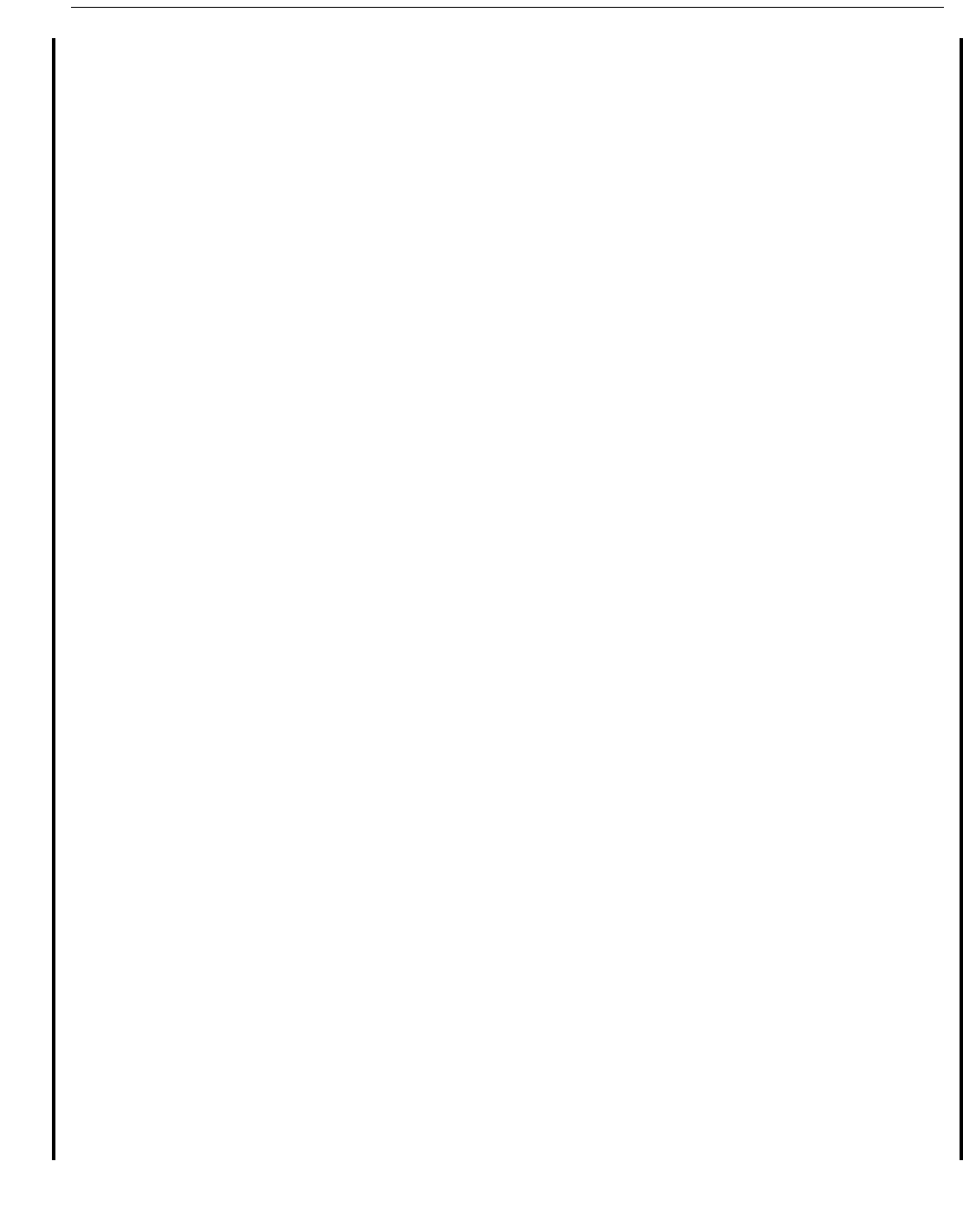
180 API RECOMMENDED PRACTICE 2A-WSD
tions, except that the 0.8 factor in the formula for allowable
moment capacity has been absorbed in the Q
u
term. Despite
its intuitive appeal, the punching shear alternative has been
eliminated, as computer nowadays does most joint checks.
Calibration of Safety Factor. For a WSD safety factor of
1.8, current AWS-AISC criteria for all types of tubular con-
nections in axial compression give a safety index, beta, of 2.7
(for known static loads, e.g., dead load), including a bias of
1.10 and COV of 0.08 for the material, in addition to the bias
and COV in the WRC data base (ref. 66). Tension data show
notionally higher beta; however, the data trend indicates
reduced conservatism with increasing thickness, possibly a
reflection of the well-known size effect in fracture. These cri-
teria are similar to the 1984 API criteria, except that separate
Q
q
formulas for K vs. TY vs. X were eliminated by using the
alpha ovalizing term (ref. 67).
The 1988 safety calibration of API RP 2A-WSD found that
the existing RP 2A-WSD had betas of 3.4 for 90% static load,
and 2.1 (lifetime) for 80% storm loading (100-year design
storm). The higher safety level was deemed appropriate for
periods when the platforms are manned and loads are under
human control. A target beta of 2.44 across the board was
proposed for RP 2A-LRFD (ref. 68).
Rather than just matching the risk level of these bench-
mark criteria, a higher reliability, afforded by more accurate
equations, was also considered. The approach was to find a
single WSD safety factor, which produces betas in a desir-
able range across the range of joint types and load cases.
This has been done in a way, which permits comparison with
WSD precedents.
Combined statistics were assembled for the Offshore
Tubular Joints Research Committee (OTJRC) data set, which
includes 1115 joints of all types with compressive axial loads,
similar to the earlier ASCE and AWS-AISC calibrations with
much smaller data sets. Including the effect of material varia-
tions, this results in a bias of 1.35, the same as AWS-AISC,
but the COV is substantially lower, 0.16 vs. 0.28.
Then beta, dead load safety index for the composite data
set, was computed, using various trial safety factors.
Because of the lower scatter (COV), huge reductions in the
safety factor would have still given reasonable betas for
known static loads. However, for further study, a modest
reduction of the WSD safety factor to 1.6 was chosen.
Whereas API’s existing WSD safety factor of 1.7 corre-
sponded to an LRFD resistance factor of 0.95, a WSD safety
factor of 1.62 (rounded off to 1.6) would correspond to an
LRFD resistance factor of 1.0. A resistance factor of 1.0 is
used in AWS-AISC and other CIDECT-based international
codes for chord face plasticization in tubular connections
using RHS.
There are twenty combinations of joint type, load type, and
data type (finite element vs. physical test) in the OTJRC data-
base. A spreadsheet was used to examine the safety perfor-
mance of each combination, to see if a constant safety factor
produces results in an acceptable range. Values of the safety
index, beta were calculated for both 100% dead load (bias =
1.0, COV = 0), and 100% storm load (bias = 0.7, COV =
0.37, from Moses’ 1988 OTC paper), for both existing API-
WSD criteria and the corresponding OTJRC proposal. A log-
normal safety format was used.
The resulting 80 betas are plotted as histograms on Figures
C4.3.2-1 and C4.3.2-2. Static results are compared to target
betas from AWS-AISC and Moses’ 1988 calibration for ten-
sile yielding. Storm results are compared to Moses’ 1988 ten-
sile yielding calibration for a 100-year design.
API RP 2A-WSD 21
st
Edition, with SF = 1.7. Static
betas for compressive axial load tests are safely in the range
of 5 to 6, and most of the experimental betas (shaded) meet
the target criteria. However, there is tremendous scatter, and
most of the finite element betas fail to meet the targets. The
test results are what the criteria were originally based upon.
The finite element results cover a wider range of chord load-
ing cases (Q
f
effect) than was previously considered, and con-
tain some bad news.
Storm betas tell a similar story. Compressive axial load
tests (darker shading) are all acceptable, but some of the
experimental results, and almost all of the finite element
cases, are not.
OTJRC Static Strength Criteria, with SF = 1.6. The
static betas are all acceptable, and their range of scatter is
much reduced by the new criteria. Three cases (shaded) out of
20 are less conservative than existing API; these are the
experimental axial compression cases. The composite beta
(combining all joint types and load cases) is also shown. This
shows considerable improvement in reliability over previous
calibrations.
The storm betas are all acceptable, and fall in a tight clus-
ter, except for the notionally more conservative tension test
results. This is because the large storm load uncertainty over-
whelms the small COVs on joint strength, making mean bias
and safety factor (both elements of reserve strength) more
important.
Conclusion. The WSD safety factor of 1.6 has been
adopted for use with the new OTJRC static strength criteria.
Static betas greatly exceed target values from precedent, ben-
efiting from reduced scatter, but they do not govern. When
the one-third increase is used for storm loadings, the safety
factor becomes 1.2. Storm betas are clustered on the safe side
of the API-WSD precedent.
C4.3.3 Strength Factor Q
u
The various Q
u
factors have been derived from appraisals
of screened steel model data, supplemented by finite element
(FE) data, for each joint and load type. In recommending the
05
05
Copyright American Petroleum Institute
Provided by IHS under license with API
Licensee=Indonesia location/5940240008
Not for Resale, 10/22/2008 00:07:12 MDT
--`,,```,,,`,,,,,,,,,,,,,,`,``,`-`-`,,`,,`,`,,`---
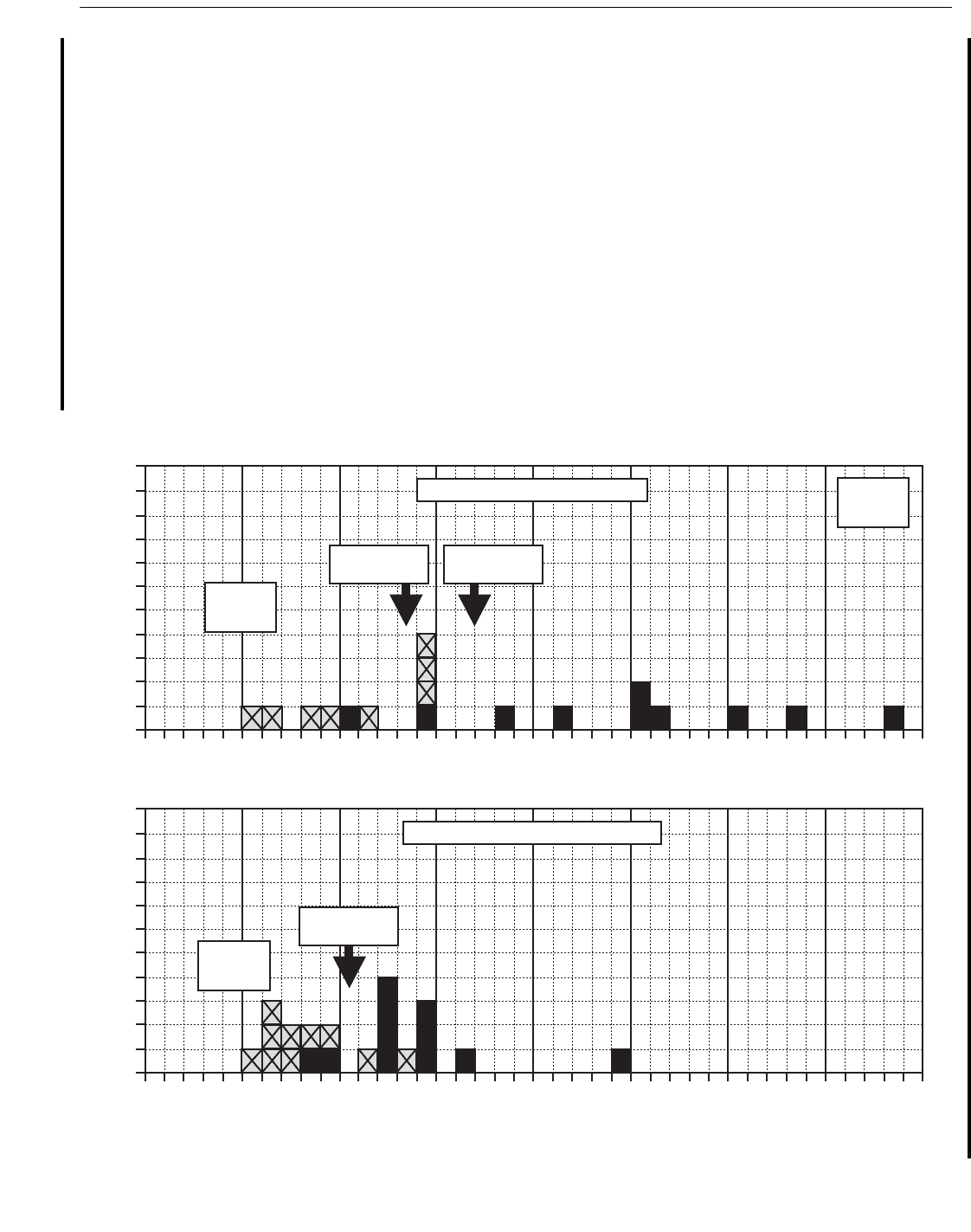
RECOMMENDED PRACTICE FOR PLANNING, DESIGNING AND CONSTRUCTING FIXED OFFSHORE PLATFORMS—WORKING STRESS DESIGN 181
factors, the formulations of existing codes were examined
and the best formulations for capturing the effects of the joint
parameters (e.g., β and γ) were selected and the coefficients
adjusted to give characteristic strength values. In some cases,
new formulations are provided where significant improve-
ments in the coefficient of variation (COV) have been found
or where the new formulation has a wider range of applicabil-
ity. In particular, the axial load formulation for overlapped K
joints applies to the former, and the out-of-plane bending for-
mulation applies to the latter.
The API/EWI FE study (Refs. 21 to 28) shows a depen-
dence of the basic strength factor Q
u
on γ (as well as β)
which is more obvious at large γ where there are less experi-
mental data. The experimental database (Refs. 5 and 7) for
DT/X joints under axial compression and K joints under bal-
anced axial loading tends to show a somewhat weaker
dependence on g and this is reflected in the recommended
strength factors shown in Table 4.3-1. This dependence of
Q
u
on γ has not previously been recognized in API RP 2A-
WSD (with one exception, i.e., the gap factor Q
g
for axially
loaded K joints with γ ≤ 20).
The gap factor Q
g
for K joints under balanced axial load is
now expressed in terms of g/D rather than g/T (for γ ≤ 20),
eliminating the g dependence formerly included in Q
g
for γ ≤
20. The API/EWI finite element studies show that with Q
u
given as (16 + 1.2 γ)β
1.2
Q
g
, no significant additional effect of
γ on Q
g
remains for gap joints.
For overlap joints, there is a large effect of γ. The equations
for Q
g
are not defined for |g/D| less than 0.05. Linearly inter-
polated value between the limiting values of the two Q
g
expressions may be used for assessment. However, the
designer may wish to consider that this was formerly a for-
bidden zone. International equations for strength and SCF
indicate a smooth transition in this region, but IIW s/c XV-E
still recognizes a forbidden zone. Service cracking has been
observed in joints that had too small an overlap, creating a
10
5
0
1234
Safety Index Beta
5678
Number of Results
Black boxes are test data.
Safety
Factor
= 1.7
100%
Dead
Load
AWS-AISC
Avg. Beta
API-WSD
Moses '88
10
5
0
1234
Lifetime Safety Index Beta
5678
Number of Results
Black boxes are lower than existing API.
100%
Wave
Load
API-WSD
Moses '88
Figure C4.3.2-1—Safety Index Betas, API RP 2A-WSD Edition 21 Formulation
05
05
Copyright American Petroleum Institute
Provided by IHS under license with API
Licensee=Indonesia location/5940240008
Not for Resale, 10/22/2008 00:07:12 MDT
--`,,```,,,`,,,,,,,,,,,,,,`,``,`-`-`,,`,,`,`,,`---
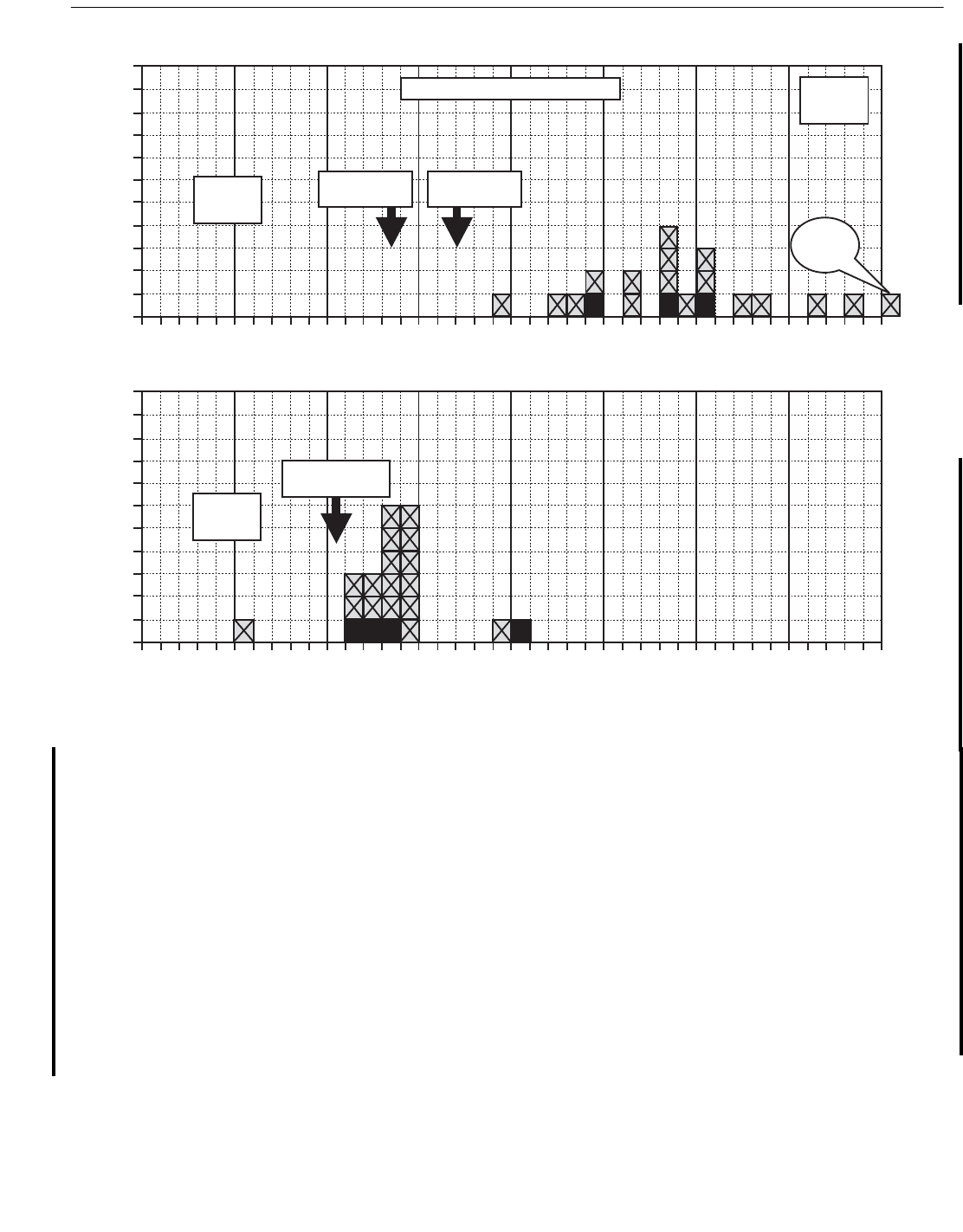
182 API RECOMMENDED PRACTICE 2A-WSD
stiff but weak load path, with prying on the root of the hidden
weld. Very small gaps (less than 2 inches or 0.1βD, which-
ever is smaller) make welding access difficult at the point of
highest load transfer.
The brace in-plane bending strength for K joints is based
on the governing case (Refs. 24 and 27) of equal magnitude
closing moments (closing moments tend to increase the angle
between chord and brace). Because no generally accepted
classification scheme for brace moment loadings is available,
the K joint closing moment capacity dictates the allowable in-
plane bending capacity of all joint types.
The brace out-of plane bending strength for K joints is
based on the governing case (Refs. 24 and 27) of equal mag-
nitude aligned moments (aligned out-of-plane moments tend
to bend both braces out-of-plane to the same side of the
chord). The K joint out-of-plane aligned moment capacity
dictates the allowable out-of-plane bending capacity of all
joint types.
The strength factor Q
u
for axially loaded T joints is given
for a condition in which the effect of the equilibrium-induced
global chord bending moment is eliminated. The effect of this
chord bending moment must be accounted for in the chord
load factor Q
f
as described in C4.3.4 below.
The Q
u
formulations for tension loaded T/Y and DT/X
joints have been derived on the basis of loads at which crack-
ing has been observed in test data. However, tension loaded
joints made of thin or extremely tough steel (Ref. 35) can sus-
tain further loading beyond first crack. As an estimate of this
reserve strength may be important in predominantly statically
loaded joints, characteristic ultimate tensile strength expres-
sions have been developed in Ref. 5 and are given below.
Figure C4.3.2-2—Safety Index Betas, API RP 2A-WSD Edition 21, Supplement 2 Formulation
10
5
0
1234
Safety Index Beta (B)
5678
Number of Results
Black boxes are test data.
Safety
Factor
= 1.6
100%
Dead
Load
AWS-AISC
Avg. Beta
API-WSD
Moses '88
10
5
0
1234
Lifetime Safety Index Beta
5678
Number of Results
100%
Wave
Load
API-WSD
Moses '88
Average
of 8
higher
07
05
05
Copyright American Petroleum Institute
Provided by IHS under license with API
Licensee=Indonesia location/5940240008
Not for Resale, 10/22/2008 00:07:12 MDT
No reproduction or networking permitted without license from IHS
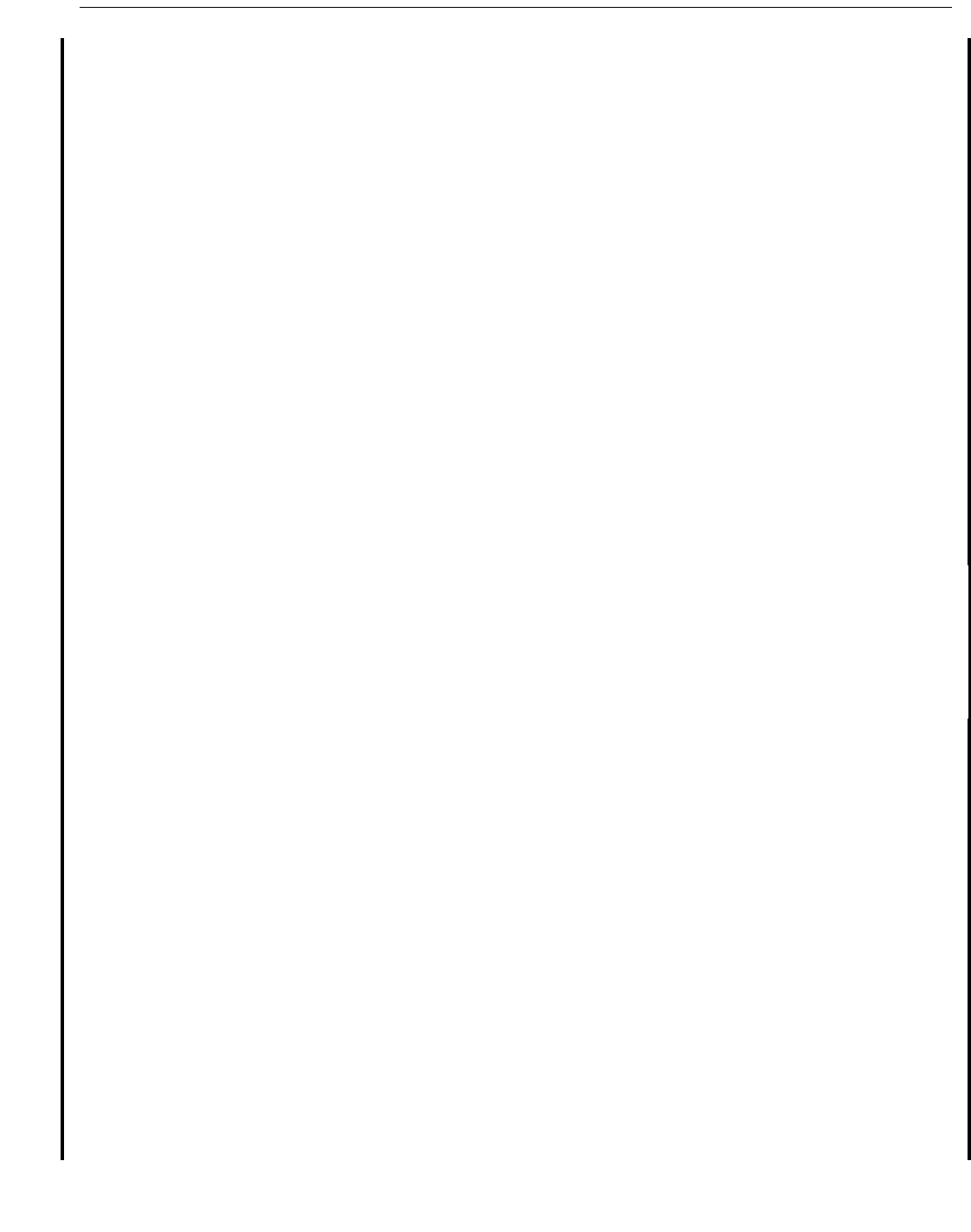
RECOMMENDED PRACTICE FOR PLANNING, DESIGNING AND CONSTRUCTING FIXED OFFSHORE PLATFORMS—WORKING STRESS DESIGN 183
(i) For T/Y joints (mean bias = 1.805, COV = 0.263):
Q
u
= 42 β – 4.1 for β ≥ 0.35
(ii) For DT/X joints (mean bias = 1.138, COV = 0.071):
Q
u
= 41 β - 1.9 for β ≤ 0.9
= 35 + (β - 0.9) (32 γ - 285) for β > 0.9
The bias is defined as the ratio of measured (test or FE)
strength to predicted strength using the recommended equa-
tions and measured yield strength. The reliability of a formu-
lation depends on both the mean bias and the coefficient of
variation (COV); a higher mean bias and a lower COV lead to
a higher reliability.
The large increase in strength indicated in the second
expression for DT/X joints at high β relies on membrane
stresses in the chord saddle region as the load is essentially
transferred directly from one brace to the other. If there is any
significant misalignment of the braces (say, e/D > 0.2, where
e is the eccentricity of the two braces), load transfer by mem-
brane action should not be exploited, and the first expression
should be invoked over the full range of β.
In situations where fatigue cracking is evident, the strength
formulations for tension loaded T/Y and DT/X joints based
on loads at which cracking has been observed can be used to
estimate the strength of the cracked joint. This applies for
conditions in which the percentage of cracked area is not
greater than 20% of the full area. For other conditions, refer-
ence to further work published in this area (Refs. 34 to 36)
should be made to determine the strength of the joint. Also
see Ref. 64.
Example comparisons of Q
u
from Table 4.3-1 with Q
u
from earlier API RP 2A-WSD editions (e.g., the 21
st
edition
prior to this supplement) are shown in Figures C4.3.3-1 and
C4.3.3-2 for axial and moment loaded joints respectively. The
0.8 factor (see C4.3.2 above) has been applied to enable a fair
comparison to be made.
C.4.3.3.1 Design for Axial Load in General and
Multiplanar Connections
For general and multiplanar connections, the nominal axial
joint strength for each of N primary branch members may be
checked in turn (starting with the largest punching load P
sinθ to initially size the chord) with Q
u
as follows:
Q
u
= [3.4 + 32 β/α] Q
β
e
where
α = defined in Figure C4.3.3-2, with 1.0 < α <
1+0.7N
Q
β
= defined in Table 4.3-1, note (a)
e =0.7(α-1), with 0 < e < 1.0
Lightly loaded secondary bracing members at such con-
nections may simply be checked as T- or Y-connections.
C4.3.4 Chord Load Factor Q
f
Compared to the 21
st
edition of API RP 2A (prior to this
supplement), a substantial change to the chord load factor Q
f
is given in 4.3.4:
1. The chord load factor Q
f
given in Equation 4.3-2
includes linear terms in the nominal chord axial load
and in-plane bending moments, in addition to the qua-
dratic terms retained in the parameter A (Eq. 4.3-3).
This is similar in form to the chord stress function pro-
posed in Ref. 29 and adopted in the CIDECT design
guide (Ref. 16).
2. Equation 4.3-2 applies over the full range of chord
loads. Previous versions of API RP 2A contained the
additional provision that Q
f
= 1.0 when all extreme
fiber stresses in the chord are tensile. This provision
had the unintended consequence that Q
f
exhibited a
step discontinuity when both axial and bending loads
existed in the chord. The new formulation may pro-
duce a Q
f
<1.0 even when the chord is subjected to an
axial tension load, particularly in high β (β > 0.9) DT
joints under brace axial compression.
3. Inspection of the Q
f
term shows that there is now no
dependence on γ. Previously, API RP 2A included such
dependence; this was based on forcing the Q
f
factors of
X joints of a specific γ and K joints of another specific
γ to align. The appraisals in Refs. 5 and 7 indicate that
any γ dependence in K joints is small. The API/EWI
FE studies also show only a slight dependence of the
chord load factor on γ, for all joint types and brace
loading conditions. The presence in Q
f
of the γ-depen-
dence in previous versions of API RP 2A-WSD leads
to gross underestimates of the capacity of high γ joints
with high axial chord loads.
Example comparisons of Q
f
from Equations 4.3-2, 4.3-3
and Table 4.3-2 with Q
f
from earlier API RP 2A-WSD edi-
tions (e.g. the 21
st
edition prior to this supplement) are shown
in Figure C4.3.4-1. These comparisons show the effect of
chord axial load (FS P
c
/P
y
) on Q
f
. Corresponding plots of Q
f
as a function of chord in-plane bending load (FS M
ap
/M
P
)
would be symmetric in (FS M
ap
/M
P
), except for K joints
under balanced brace axial loading (for which the coefficient
C
2
in Table 4.3-2 is non-zero). For that case a positive M
ap
(producing compression on the K joint footprint) yields a
value Q
f
<1.0, while a negative M
ap
of the same magnitude
has a less deleterious effect (larger Q
f
), and may actually pro-
duce a slight capacity enhancement (Q
f
>1.0). Although this
behavior may be expected generally for joints that are not
symmetric about the chord axis, the recommended formula-
tion of Q
f
for T joints (Table 4.3-2) does not incorporate the
beneficial effect of a negative M
ap
for brace axial compres-
sion (or a positive M
ap
for brace axial tension) because there
is not sufficient data available to reliably quantify it.
05
07
05
07
07
05
07
Copyright American Petroleum Institute
Provided by IHS under license with API
Licensee=Indonesia location/5940240008
Not for Resale, 10/22/2008 00:07:12 MDT
No reproduction or networking permitted without license from IHS
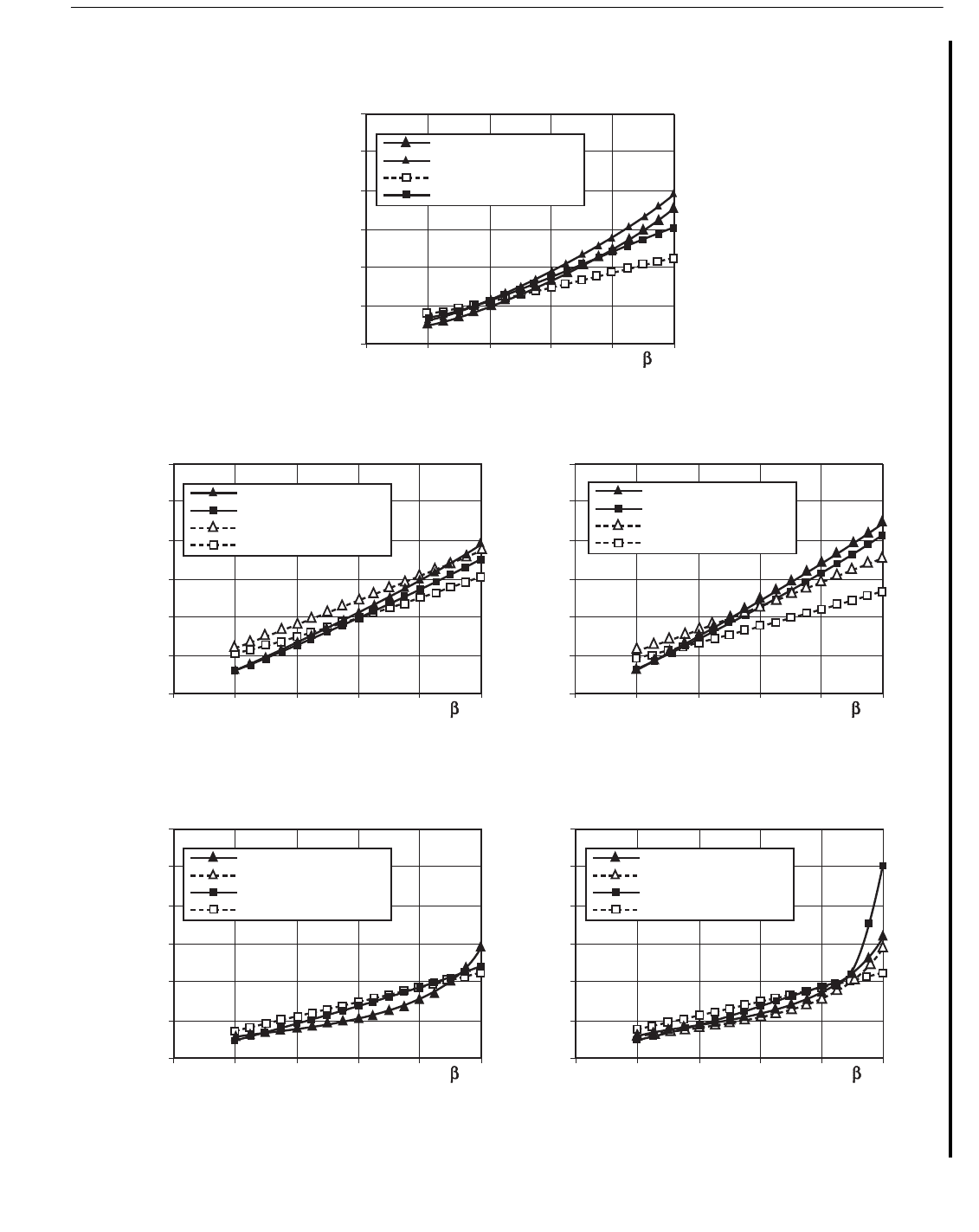
184 API RECOMMENDED PRACTICE 2A-WSD
Figure C4.3.3-1—Comparison of Strength Factors Q
u
for Axial Loading
0.0
G = 30
G = 15
T joints: axial loading
Q
u
60
50
40
30
20
10
0
0.2 0.4 0.6 0.8 1.0
New API (Comp)
New API (Comp)
Old API (Tens & Comp)
New API (Tens)
0.0
G = 15
K joints: balanced axial loading. G = 15
Q
u
60
50
40
30
20
10
0
0.2 0.4 0.6 0.8 1.0
New API (g/D=0.5)
New API (g/D=0.15)
Old API (g/D=0.05)
Old API (g/D=0.15)
0.0
G = 30
K joints: balanced axial loading. G = 30
Q
u
60
50
40
30
20
10
0
0.2 0.4 0.6 0.8 1.0
0.0
G = 15
X joints: axial loading. G = 15
Q
u
60
50
40
30
20
10
0
0.2 0.4 0.6 0.8 1.0
New API (Comp)
Old API (Comp)
New API (Tens)
Old API (Tens)
0.0
G = 30
X joints: axial loading. G = 30
Q
u
60
50
40
30
20
10
0
0.2 0.4 0.6 0.8 1.0
New API (Comp)
Old API (Comp)
New API (Tens)
Old API (Tens)
New API (g/D=0.05)
New API (g/D=0.15)
Old API (g/D=0.05)
Old API (g/D=0.15)
07
Copyright American Petroleum Institute
Provided by IHS under license with API
Licensee=Indonesia location/5940240008
Not for Resale, 10/22/2008 00:07:12 MDT
No reproduction or networking permitted without license from IHS
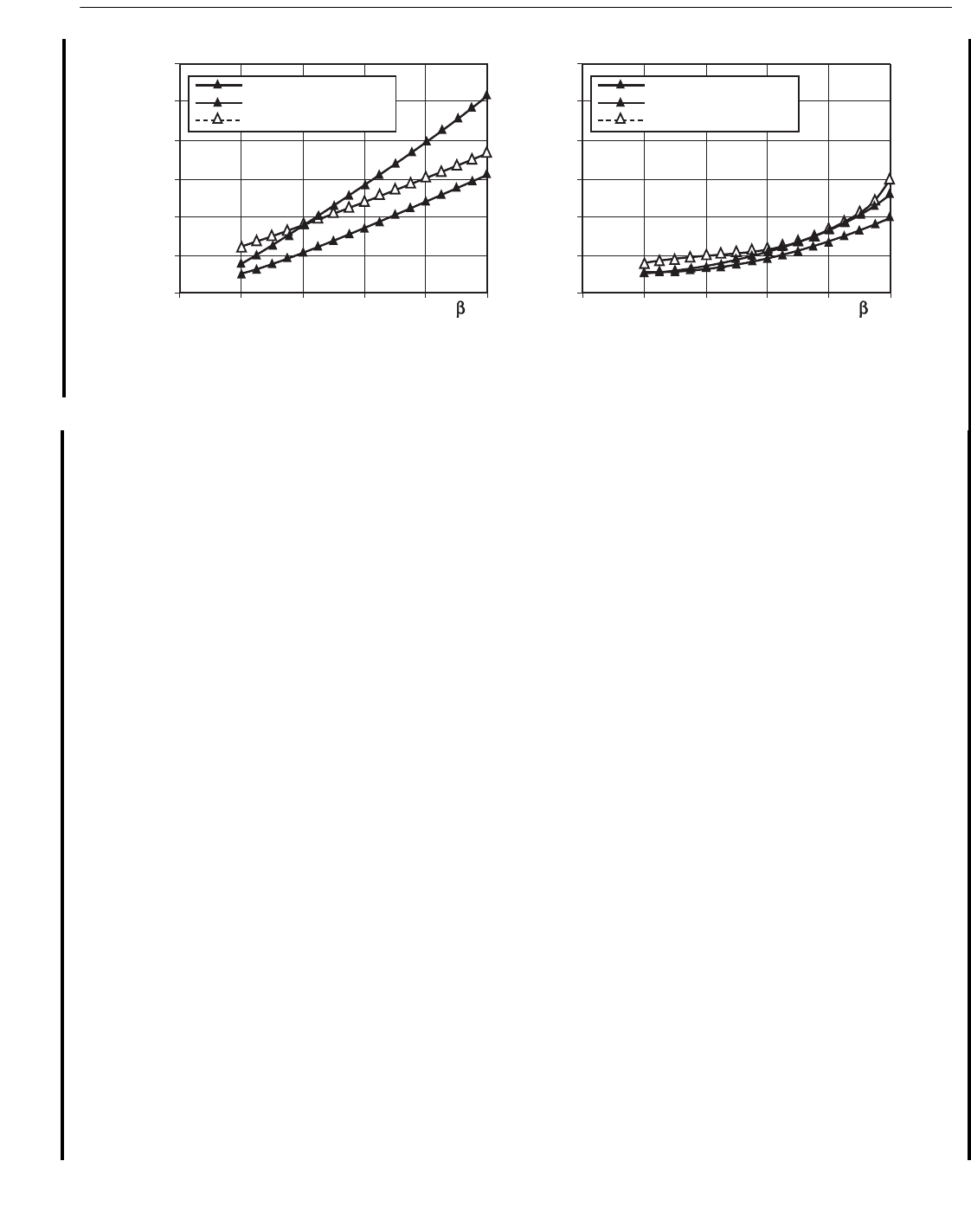
RECOMMENDED PRACTICE FOR PLANNING, DESIGNING AND CONSTRUCTING FIXED OFFSHORE PLATFORMS—WORKING STRESS DESIGN 185
The plots of Q
f
for DT joints under brace axial compression
(Figure C4.3.4-1) show the marked transition in the effect of
axial chord load on capacity that occurs between 0.9 < β ≤1.0.
Chord axial compression significantly reduces brace axial
compression capacity in low to moderate β DT joints
(Ref.31), but has no appreciable effect for joints with β ≈1.0
(Ref.32). Chord axial tension, on the other hand, has little
effect on low to moderate β DT joints, but reduces brace axial
compression capacity for high β (β ≈1.0) joints (Refs. 23, 25
and 31). Figure C4.3.4-2 shows results of tests performed at
the University of Texas (Refs. 31 and 32) on a series of DT
joints with different β values (0.35, 0.67, 1.0), subjected to
brace and chord axial compression loads. The test results are
normalized for each geometry by the strength measured in
nominally identical specimens with no chord load. These nor-
malized results provide an experimental evaluation of the
chord load factor for these joints, and they are compared with
the recommended chord load factor Q
f
in Figure C4.3.4-2.
In most cases, brace loads induce equilibrium chord loads.
For example, in a K joint with no joint eccentricity under bal-
anced brace axial load, equilibrium axial loads are induced in
the chord (tension on one side of the brace intersection and
compression on the other side). In a T joint under brace in-
plane bending, equilibrium in-plane bending moments are
induced in the chord (positive on one side of the brace inter-
section and negative on the other). In both of these cases the
relative magnitudes of the positive and negative equilibrium
chord loads and bending moments depend on the relative
stiffnesses and remote-end boundary conditions of the chord
on either side of the brace intersection. A qualitatively differ-
ent situation occurs in, for example, a T joint under brace
axial compression. In that case, an equilibrium chord in-plane
bending moment is induced on both sides of the brace inter-
section. The magnitude of the equilibrium bending moment
depends not only on the relative stiffnesses and remote-end
boundary conditions of the chord on either side of the brace
intersection, but also strongly depends on chord absolute
length. This poses a significant problem in testing T joints
with high β values: because of the large axial capacity of
these joints, substantial equilibrium in-plane bending
moments are generated that may affect joint strength (Ref.
37) or even cause premature (i.e., before joint failure) chord
plasticization. Smaller chord lengths reduce the equilibrium
bending moments, but below some minimum length, the
chord end conditions begin to influence the joint strength.
In the API/EWI FE analyses of T joints under brace axial
compression, compensating negative in-plane bending
moments, proportional to the brace load, are applied at the
chord ends, so that the global bending moment at the intersec-
tion of the brace and chord centerlines remains zero through-
out the loading history. The strength factor Q
u
determined
from these FE analyses therefore represents the joint capacity
corresponding to a very short chord, without the effect of the
equilibrium chord bending moments. A series of FE analyses
with different levels of additional applied chord bending
moments (reflected in Q
f
) allows the estimation of joint
strength for different levels of chord global bending.
Therefore, equilibrium chord loads are present and
accounted for in the strength factors Q
u
determined from
tests, and (with the single exception of axially loaded T joints,
in which the effects of equilibrium chord bending moments
are explicitly removed) they are also present and accounted
for in the strength factors Q
u
determined from the EWI/API
FE database.
In order to determine the additional chord loads to be
accounted for in the chord load factor Q
f,
the average of the
total (equilibrium plus additional) chord loads on either side
of the brace intersection should be used.
In cases (including the API/EWI FE analyses, and the vast
majority of tests) where the chord cross-sections, lengths and
Figure C4.3.3-2—Comparison of Strength Factors Q
u
for IPB and OPB
(Note: API [21st ed.] Q
u
multiplied by 0.8 factor for comparisons)
0.0
G = 30
G = 15
All joints: IPB
Q
u
30
25
20
15
10
5
0
0.2 0.4 0.6 0.8 1.0
New API (Comp)
New API (Comp)
Old API (Tens & Comp)
0.0
G = 30
G = 15
All joints: OPB
Q
u
30
25
20
15
10
5
0
0.2 0.4 0.6 0.8 1.0
New API (Comp)
New API (Comp)
Old API (Tens & Comp)
07
07
07
05
05
Copyright American Petroleum Institute
Provided by IHS under license with API
Licensee=Indonesia location/5940240008
Not for Resale, 10/22/2008 00:07:12 MDT
--`,,```,,,`,,,,,,,,,,,,,,`,``,`-`-`,,`,,`,`,,`---
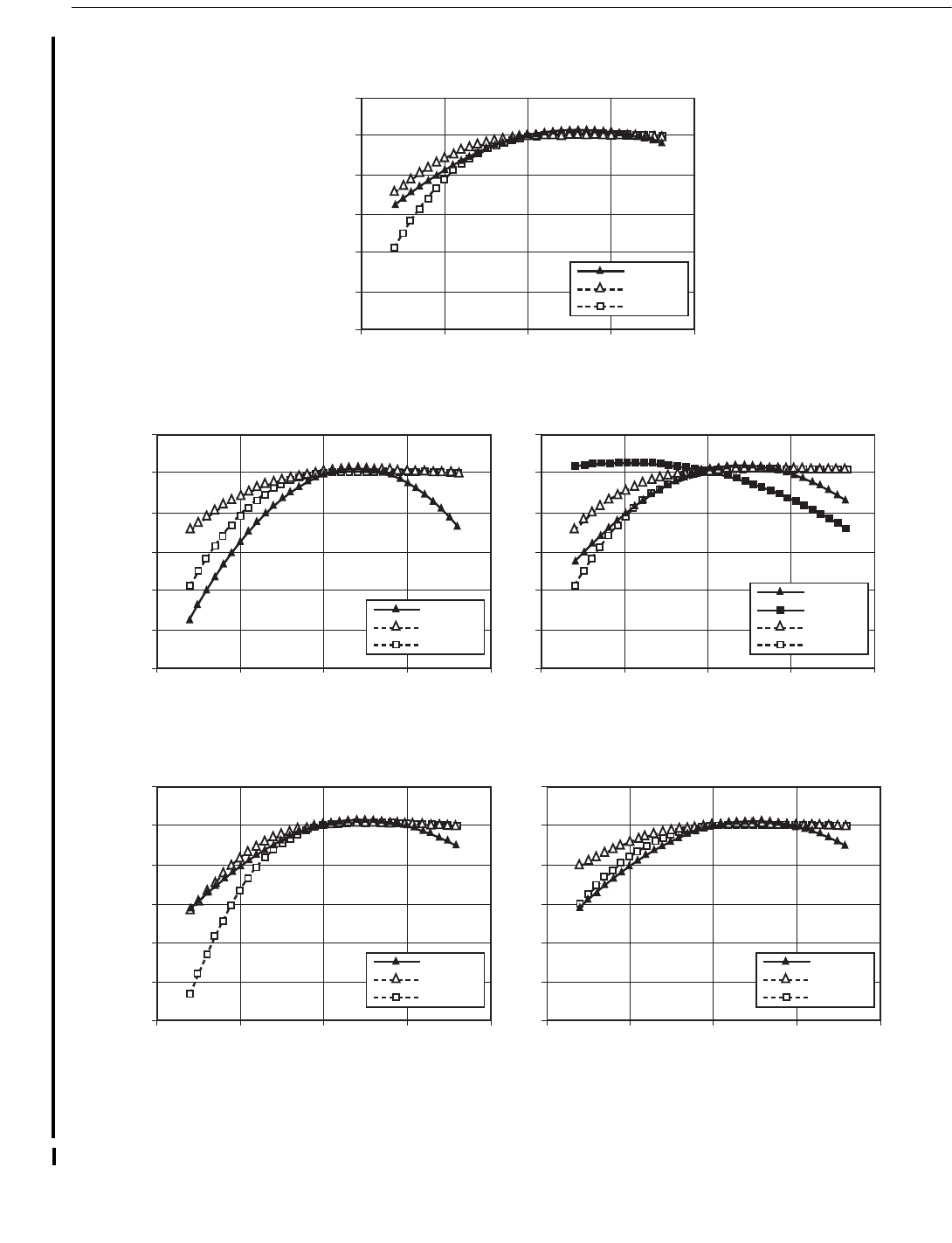
186 API RECOMMENDED PRACTICE 2A-WSD
Figure C4.3.4-1—Comparison of Chord Load Factors Q
f
-1.0
G = 30
G = 15
K joints: brace axial loading
Q
f
1.2
1.0
0.8
0.6
0.4
0.2
0.0
-0.5 0.0 0.5
FS P
c
/P
y
1.0
New API
Old API
Old API
-1.0
G = 30
G = 15
T joints: brace axial loading
Q
f
1.2
1.0
0.8
0.6
0.4
0.2
0.0
-0.5 0.0 0.5
FS P
c
/P
y
1.0
New API
Old API
Old API
-1.0
G = 30
G = 15
All joints: brace IPB All joints: brace OPB
Q
f
1.2
1.0
0.8
0.6
0.4
0.2
0.0
-0.5 0.0 0.5
FS P
c
/P
y
1.0
New API
Old API
Old API
-1.0
G = 30
G = 15
Q
f
1.2
1.0
0.8
0.6
0.4
0.2
0.0
-0.5 0.0 0.5
FS P
c
/P
y
1.0
New API
Old API
Old API
-1.0
G = 30
B = 1.0
B = 0.9
G = 15
X joints: brace axial loading
Q
f
1.2
1.0
0.8
0.6
0.4
0.2
0.0
-0.5 0.0 0.5
FS P
c
/P
y
1.0
New API
New API
Old API
Old API
07
05
Copyright American Petroleum Institute
Provided by IHS under license with API
Licensee=Indonesia location/5940240008
Not for Resale, 10/22/2008 00:07:12 MDT
--`,,```,,,`,,,,,,,,,,,,,,`,``,`-`-`,,`,,`,`,,`---
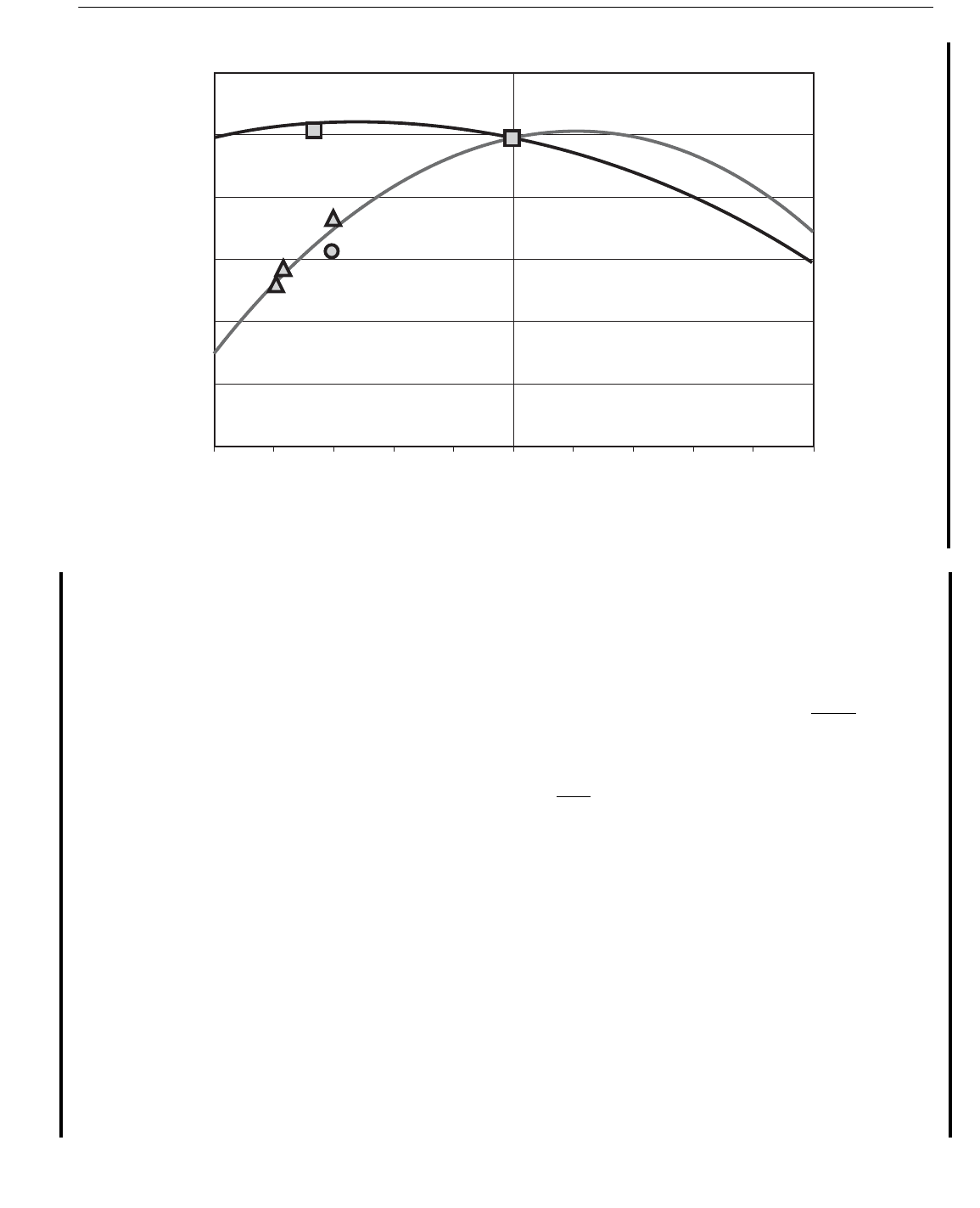
RECOMMENDED PRACTICE FOR PLANNING, DESIGNING AND CONSTRUCTING FIXED OFFSHORE PLATFORMS—WORKING STRESS DESIGN 187
remote-end boundary conditions are the same on both sides
of the brace intersection, averaging the total chord loads on
either side of the brace intersection yields the correct addi-
tional chord load since the equilibrium chord loads cancel
from the sum. More generally, in cases where the chord does
not react the equilibrium loads equally on either side of the
brace intersection, the averaging procedure produces a small
equivalent additional chord load that is taken into account in
Q
f
. In the axially loaded T joint, the equilibrium chord bend-
ing moment is the same on both sides of the brace intersec-
tion, and so it is properly accounted for in the average chord
bending moment.
Implicit in this simple averaging procedure is the assump-
tion that the capacity of the joint is not significantly affected
by small variations in the sequence of brace vs. chord loading.
Brace load capacities calculated from Equations 4.3.1 to
4.3.3 (with the factor of safety FS = 1) were compared with
the screened test data and with the API/EWI FE data, for K,
Y, and X joints for the four brace load cases. The result of
each individual comparison was expressed in the form of a
ratio of (Test or FE Strength)/(Predicted Strength). Ratios
greater than one, indicating that the joint capacity is greater
than the predicted value, are obviously desirable. Statistics of
the comparisons are given in Tables C4.3-1 to C4.3.4-1 for K,
Y and X joints, respectively, for the four brace load cases. For
each category (joint type & brace load), the mean bias, COV,
and number of cases (tests or FE) N are given. The same com-
parisons were made for the previous API RP 2A-WSD (21
st
edition prior to this supplement) provisions, and the statistics
of those comparisons are also given in these Tables.
It is clear that both the Q
u
formulation alone, and the com-
bined Q
u
Q
f
formulation given in Equations 4.3.1 to 4.3.3 is a
great improvement over that of the previous API practice,
particularly for brace bending loads. The former
conclusion
can be drawn by comparisons with the complete screened test
database, since it contains relatively few cases with additional
chord loads in most of the joint type/brace load categories.
The latter
conclusion is drawn by comparisons with the API/
EWI FE database, which contains a relatively high proportion
of cases with additional chord loads. In any case, the assess-
ment of the accuracy of a chord load formulation cannot be
uncoupled from that of the strength factor, even if a test data-
base with a substantially higher proportion of cases with addi-
tional chord loads were in existence.
Figures C4.3.4-3 to C4.3.4-5, for the brace axial load
cases, and Figures C4.3.4-6 and C4.3.4-7, for the brace bend-
ing cases, show the results of the comparisons plotted against
β. These figures show that the performance of the recom-
mended and previous API formulations is consistent across
joint type and brace load conditions for both test and FE data-
bases. Additional comparisons (not shown) with a subset of
the FE database containing only the cases with no chord load
are also consistent with the test database comparisons for
both the recommended and previous API practice.
Figure C4.3.4-2—Effect of Chord Axial Load on DT Brace Compression Capacity
Comparison of University of Texas Test Data with Chord Load Factor
1.2
1.0
0.8
0.6
0.4
0.2
0.0
-1.0 -0.8 -0.6 -0.4 -0.2 0.0
P/P
y
0.2 0.4 0.6 0.8 1.0
Chord Load Factor Q
f
API RP2A (0<B<0.9)
API RP2A (B=1.0)
Weinstein B=1.0
Boone B=0.67
Weinstein B=0.35
07
05
05
05
Copyright American Petroleum Institute
Provided by IHS under license with API
Licensee=Indonesia location/5940240008
Not for Resale, 10/22/2008 00:07:12 MDT
No reproduction or networking permitted without license from IHS
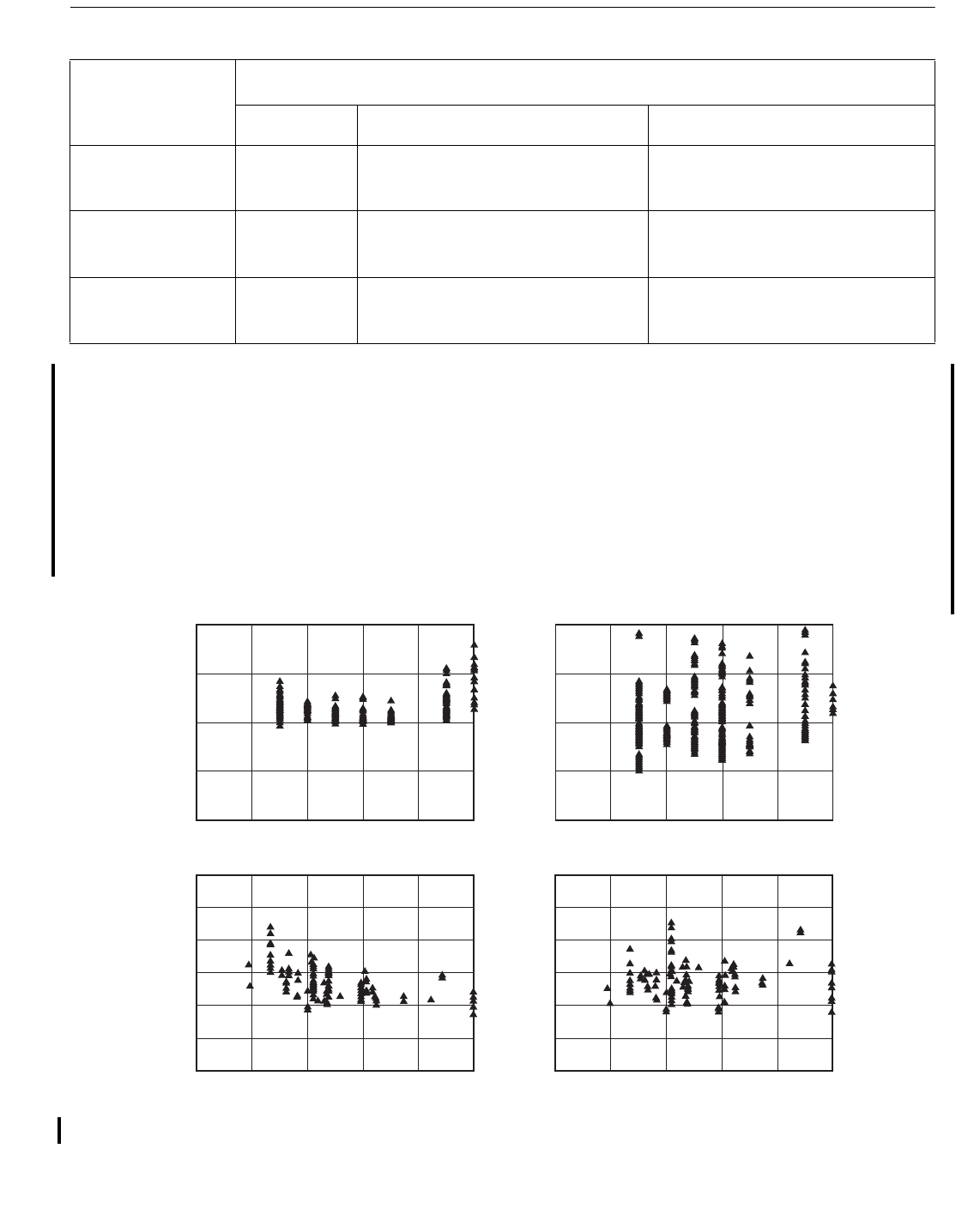
188 API RECOMMENDED PRACTICE 2A-WSD
C4.3.5 Joints with Thickened Cans
The reduced strength for axially loaded simple Y- and X-
joints having short can lengths is supported by numerical and
experimental data, see Ref. 5. No reduction in capacity is
required for axially loaded K joints.
The previous API provisions for load transfer across
chords have been extended to cover axially loaded T joints.
Axially loaded X joints with β > 0.9 increasingly transfer
load across the chord through membrane action, and this ben-
eficial mechanism is recognized.
The provisions are also intended for application to other
cases where load-transfer through chords occurs, e.g., launch
truss joints. However, the lack of data has precluded an
assessment of capacity reduction (if any) for moment loaded
or complex joints.
C4.3.6 Strength Check
The interaction ratio for the joint is evaluated using an
interaction equation, which represents a change from the trig-
onometric ones that have historically existed in API. How-
ever, the recommended equation is identical to that already in
use in the UK (Refs. 39 and 40) and it is supported by experi-
Table C4.3-1—Mean Bias Factors and Coefficients of Variation for K Joints
Brace Loading
K Joints
Test Database FE Database
API
21
st
Edition Supplement
API
21st Edition
API
21
st
Edition Supplement
API
21st Edition
Balanced Axial
Mean Bias
COV
N
1.34 1.38 1.14 1.18
0.17 0.18 0.11 0.42
161 440
In-Plane Bending
Mean Bias
COV
N
1.47 1.29 1.32 0.94
0.15 0.09 0.17 0.50
6242
Out-of-Plane Bending
Mean Bias
COV
N
1.54 1.15 1.2 0.84
0.19 0.14 0.11 0.14
7306
0.0
K Joints: Balanced Axial Loading: FE vs. New API
FE/New API
2.0
1.5
1.0
0.5
0.0
0.2 0.4 0.6 0.8 1.0
0.0
K Joints: Balanced Axial Loading: Test vs. New API
Test/New API
3.0
2.5
2.0
1.5
1.0
0.5
0.0
0.2 0.4 0.6 0.8 1.0
0.0
3.0
2.5
2.0
1.5
1.0
0.5
0.0
0.2 0.4 0.6 0.8 1.0
K Joints: Balanced Axial Loading: Test vs. Old API
Test/Old API
0.0
K Joints: Balanced Axial Loading: FE vs. Old API
FE/Old API
2.0
1.5
1.0
0.5
0.0
0.2 0.4 0.6 0.8 1.0
BB
BB
Figure C4.3.4-3—K Joints Under Balanced Axial Loading–Test & FE vs. New & Old API
00
07
05
Copyright American Petroleum Institute
Provided by IHS under license with API
Licensee=Indonesia location/5940240008
Not for Resale, 10/22/2008 00:07:12 MDT
No reproduction or networking permitted without license from IHS
